
Galena is the largest city in and the county seat of Jo Daviess County, Illinois, with a population of 3,308 at the 2020 census. A 581-acre (235 ha) section of the city is listed on the National Register of Historic Places as the Galena Historic District. The city is named for the mineral galena, which was in the ore that formed the basis for the region's early lead mining economy.

Mineral Point is a city in Iowa County, Wisconsin, United States. The population was 2,581 at the 2020 census. The city is located within the Town of Mineral Point. Mineral Point is part of the Madison Metropolitan Statistical Area.
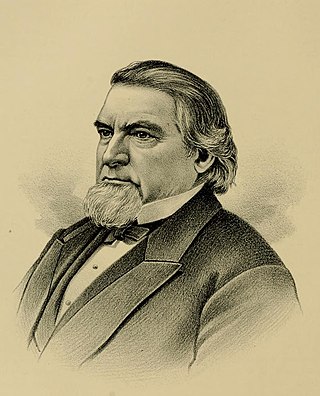
Cadwallader Colden Washburn was an American businessman, politician, and soldier who founded a mill that later became General Mills. A member of the Washburn family of Maine, he was a U.S. Congressman and governor of Wisconsin, and served as a general in the Union Army during the American Civil War.
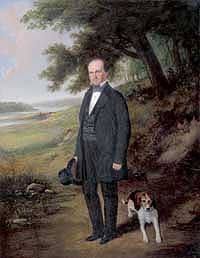
Morgan Lewis Martin was a delegate to the United States House of Representatives from Wisconsin Territory during the 29th United States Congress (1845–1847). He also served as a member of the Wisconsin State Senate and Wisconsin State Assembly, and served as a county judge in Brown County, Wisconsin.

First Capitol Historic Site is a free-admission historic museum located outside Belmont, Wisconsin, United States. The museum includes two of the buildings first used by legislators to meet in Wisconsin Territory. Currently owned and operated by the Wisconsin Historical Society, the site is listed on the National Register of Historic Places.

Pendarvis is a historic site located in Mineral Point, Iowa County, Wisconsin, United States. The site, which is listed on the National Register of Historic Places, is made up of several 19th century cabins built by Cornish immigrants who came to Mineral Point to mine lead. Today the site is owned by the Wisconsin Historical Society and serves as a museum of Wisconsin's early lead mining history. Programs at the site also interpret the groundbreaking preservation work by Robert Neal and Edgar Hellum, begun during the Great Depression.

The Walter H. Gale House, located in the Chicago suburb of Oak Park, Illinois, was designed by Frank Lloyd Wright and constructed in 1893. The house was commissioned by Walter H. Gale of a prominent Oak Park family and is the first home Wright designed after leaving the firm of Adler & Sullivan. The Gale House was listed on the U.S. National Register of Historic Places on August 17, 1973.

William Stephen Hamilton, a son of Alexander Hamilton and Elizabeth Schuyler Hamilton, was an American politician and miner who lived much of his life in the U.S. state of Illinois and the Wisconsin Territory. Hamilton was born in New York, where he attended the United States Military Academy before he resigned and moved to Illinois in 1817. In Illinois he lived in Springfield and Peoria and eventually migrated to the lead-mining region of southern Wisconsin and established Hamilton's Diggings at present-day Wiota, Wisconsin. Hamilton served in various political offices and as a commander in two Midwest Indian Wars. In 1849 he moved to California during the California Gold Rush. He died in Sacramento, most likely of cholera, in October 1850.

The Frank J. Baker House is a 4,800-square-foot Prairie School style house located at 507 Lake Avenue in Wilmette, Illinois. The house, which was designed by Frank Lloyd Wright, was built in 1909, and features five bedrooms, three and a half bathrooms, and three fireplaces. At this point in his career, Wright was experimenting with two-story construction and the T-shaped floor plan. This building was part of a series of T-shaped floor planned buildings designed by Wright, similar in design to Wright's Isabel Roberts House. This home also perfectly embodies Wright's use of the Prairie Style through the use of strong horizontal orientation, a low hanging roof, and deeply expressed overhangs. The house's two-story living room features a brick fireplace, a sloped ceiling, and leaded glass windows along the north wall; it is one of the few remaining two-story interiors with the T-shaped floor plan designed by Wright.

The Mrs. A. W. Gridley House is a Frank Lloyd Wright designed Prairie School home in Batavia, Illinois.

The Harvey P. Sutton House, also known as the H.P. Sutton House, is a six-bedroom, 4,000-square-foot (370 m2) Frank Lloyd Wright designed Prairie School home at 602 Norris Avenue in McCook, Nebraska. Although the house is known by her husband's name, Eliza Sutton was the driving force behind the commissioning of Wright for the design in 1905–1907 and the construction of the house in 1907–1908.
The Galena–Chicago trail was a stagecoach route located in northern Illinois that ran from the mid-to-late 1830s until 1854. As indicated by its name, the route linked Chicago, located in the northeast of the state, with Galena which was located in the lead mining district of the northwest. The Chicago-Galena trail includes the "Stagecoach Trail" that runs between Galena and Lena, Illinois. East of Lena the stage route follows U.S. Route 20 and Business U.S. Route 20 through Eleroy, Freeport and Rockford to Belvidere. This road began as the old State Road number 2 established on 15 January 1836 and laid out by June 1837.

The Dr. Fred Stone Sr. Hospital is a six-story brick structure in Oliver Springs, Tennessee. Noted for its castle-like appearance and eccentric, unplanned design, the building was home to a one-doctor hospital operated by retired U.S. Army physician Fred Stone Sr. (1887–1976) in the 1940s, 1950s, and 1960s. Stone delivered over 5,000 babies while working at the hospital, and expanded the building room-by-room, floor-by-floor in his spare time. In 2006, the building was added to the National Register of Historic Places for its association with the region's medical services history, namely the transition from rural country doctors to modern hospitals.
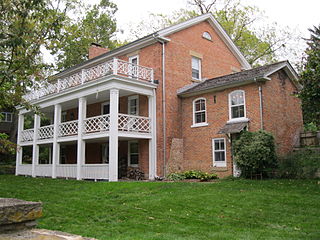
The Old Spring Tavern was built as a stopping place in 1854 on the Madison-Monroe stagecoach road. The city of Madison, Wisconsin has grown around the old Greek Revival-styled building and in 1974 it was added to the National Register of Historic Places.
John Hawkins Rountree was an American farmer, businessman, politician, and Wisconsin pioneer. He was the founder of Platteville, Wisconsin, and was instrumental in the early development of that village. He was also one of the founders of the Northwestern Mutual Insurance Company, and remained a director in the company until his death. In politics, he represented Grant County for five years in the Wisconsin Legislature, and was a delegate to Wisconsin's 2nd constitutional convention in 1847.
Thomas McKnight was an American pioneer, businessman, and politician who settled in Dubuque, Iowa.
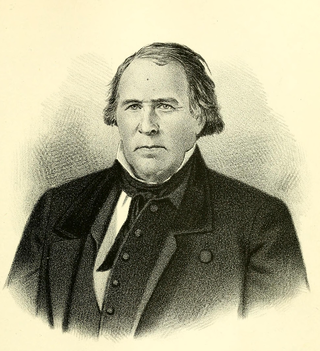
John Wilford Blackstone Sr. was an American lawyer and Wisconsin pioneer. He was Speaker of the Legislative Assembly of the Wisconsin Territory, and served as County Judge of Iowa County, when it was still organized under the Michigan Territory.
Daniel Morgan Parkinson was a farmer, hotelier, state militia officer, and holder of various offices in frontier Wisconsin, including in the legislature.
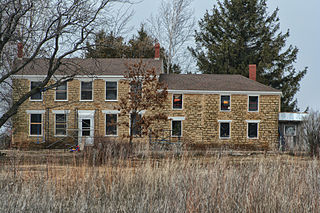
The Gratiot House, located about 2 miles (3.2 km) south of Shullsburg, Wisconsin is a Georgian-styled limestone house built by Henry Gratiot in 1835. It is the last remaining building of Gratiot Grove, one of the state's first settlements, a lead-mining outpost begun in Winnebago territory in 1826 on the stage road from Galena to Chicago. The house was listed on the National Register of Historic Places in 1980.

The August Cornelius Larson House is a Prairie Style house built in 1911 two miles southwest of the capitol in Madison, Wisconsin. In 1994 the house was added to the National Register of Historic Places as one of Madison's finest Prairie Style houses.


















